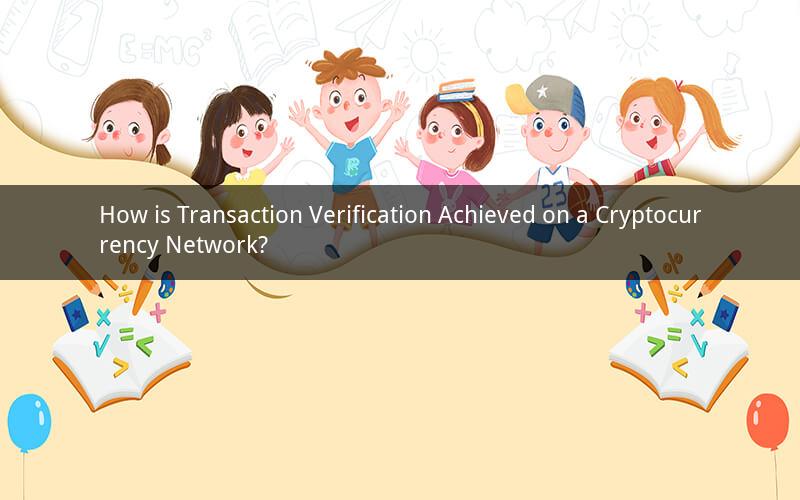
In the digital age, cryptocurrencies have gained immense popularity as a decentralized and secure means of exchange. The underlying technology, blockchain, ensures the integrity and immutability of transactions. One of the critical aspects of this technology is the verification process. This article delves into how transactions are verified on a cryptocurrency network, exploring the mechanisms and processes involved.
The Blockchain Structure
At the heart of a cryptocurrency network lies the blockchain, a distributed ledger that records all transactions. Each block contains a list of transactions, and once a block is added to the chain, it cannot be altered or deleted. This ensures the security and transparency of the network.
Transaction Verification Process
When a user initiates a transaction on a cryptocurrency network, it must be verified before it can be added to the blockchain. The process involves several steps:
1. Transaction Creation: The sender creates a transaction by specifying the recipient's address, the amount to be transferred, and a unique transaction ID. This transaction is then broadcasted to the network.
2. Network Nodes: Cryptocurrency networks consist of numerous nodes, which are computers that participate in the verification process. These nodes receive the transaction and validate it.
3. Transaction Validation: Nodes validate the transaction by checking the following:
a. The sender has sufficient funds: The sender's wallet must have enough cryptocurrency to cover the transaction amount.
b. The transaction is not double-spent: The sender has not already spent the cryptocurrency in another transaction.
c. The transaction fee is reasonable: The network requires a transaction fee to incentivize nodes to process transactions.
d. The transaction is properly formatted: The transaction must adhere to the network's protocol specifications.
4. Mining and Block Creation: Once a transaction is validated, it is added to a block. Miners, specialized nodes responsible for adding blocks to the blockchain, compete to solve complex cryptographic puzzles. The first miner to solve the puzzle gets to add the block to the blockchain and receive a reward in cryptocurrency.
5. Consensus Mechanism: To ensure the network's integrity, a consensus mechanism is employed. This mechanism allows nodes to agree on the validity of transactions and blocks. Different cryptocurrencies use various consensus mechanisms, such as Proof of Work (PoW) and Proof of Stake (PoS).
Proof of Work (PoW)
Proof of Work is a consensus mechanism used by many cryptocurrencies, including Bitcoin. In this mechanism, miners compete to solve a cryptographic puzzle. The first miner to solve the puzzle gets to add the block to the blockchain and receive a reward.
The cryptographic puzzle involves finding a number that, when hashed with the block's data, produces a hash value that meets certain criteria. This process is computationally intensive and requires significant computational power. Miners use specialized hardware, known as ASICs, to solve these puzzles.
Proof of Stake (PoS)
Proof of Stake is an alternative consensus mechanism that aims to be more energy-efficient than PoW. In PoS, validators are chosen to create new blocks based on the number of coins they hold and are willing to "stake" as collateral.
Validators are selected randomly or based on their coin age and stake size. If a validator is chosen, they must create a new block and validate transactions within that block. If the validator is honest, they receive a reward. However, if they attempt to cheat, they may lose their stake.
Transaction Verification Challenges
Despite the robustness of the transaction verification process, there are challenges that need to be addressed:
1. Scalability: As the number of transactions increases, the network may become slower and more expensive to use. This has led to the development of alternative blockchain technologies, such as sidechains and sharding.
2. Centralization: PoW and PoS mechanisms can lead to centralization, as powerful miners or validators can gain disproportionate influence over the network.
3. Security: Although the blockchain is secure, vulnerabilities in the underlying software or hardware can be exploited by malicious actors.
4. Regulatory Challenges: Cryptocurrency networks operate in a regulatory gray area, which can lead to legal issues and restrictions on their use.
In conclusion, transaction verification on a cryptocurrency network is a critical process that ensures the security and integrity of the network. By understanding the mechanisms and processes involved, we can appreciate the complexity and sophistication of blockchain technology.
Questions and Answers:
1. Q: What is the primary purpose of transaction verification on a cryptocurrency network?
A: The primary purpose of transaction verification is to ensure the security, integrity, and immutability of the network by confirming that transactions are valid and have not been double-spent.
2. Q: How does the blockchain structure contribute to transaction verification?
A: The blockchain structure contributes to transaction verification by providing a transparent and immutable ledger that records all transactions. This makes it difficult for malicious actors to alter or delete transactions.
3. Q: What are the main steps involved in the transaction verification process?
A: The main steps involved in the transaction verification process are transaction creation, network node validation, mining and block creation, and consensus mechanism.
4. Q: What are the differences between Proof of Work (PoW) and Proof of Stake (PoS) consensus mechanisms?
A: The main difference between PoW and PoS is the method of selecting validators to create new blocks. PoW relies on miners solving cryptographic puzzles, while PoS selects validators based on the number of coins they hold and are willing to stake.
5. Q: What challenges do transaction verification processes face, and how can they be addressed?
A: Transaction verification processes face challenges such as scalability, centralization, security vulnerabilities, and regulatory issues. Addressing these challenges involves developing alternative blockchain technologies, improving security measures, and navigating the regulatory landscape.